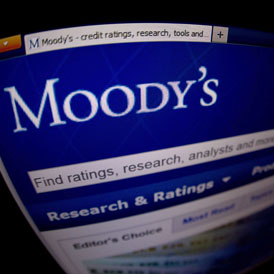Moody’s downgrade hits 15 top banks
Fears rise of increased borrowings costs after Moody’s downgrades 15 financial institutions including Royal Bank of Scotland, Barclays and HSBC.

The move has the potential to increase the cost of borrowing for banks, which in turn could pass on that cost to the public through higher mortgage and loan rates.
Richard Lloyd, an executive director at consumer rights organisation Which?, said the ratings downgrade could lead to “speculation that it will cause a further rise in mortgage rates”.
He added that banks had a history of raising interest rates because of a lack of competition on the hugh street.
The downgrade affected 12 other banks apart from the UK retail banks. Aside from RBS, HSBC, and Barclays, the agency has downgraded Bank of America, Citigroup, Goldman Sachs, JP Morgan, Credit Suisse, UBS, BNP Paribas, Credit Agricole, Societe Generale, Deutsche Bank, Royal Bank of Canada and Morgan Stanley.
The group disagrees with Moody’s ratings change which the group feels is backward-looking Royal Bank of Scotland
“All of the banks affected by today’s actions have significant exposure to the volatility and risk of outsized losses inherent to capital markets activities,” Moody’s global banking managing director Greg Bauer said in the agency’s statement.
What is the impact to the public?
Moody’s is somewhat late to the party. Ratings agencies Fitch and Standard & Poor’s exacted their downgrades in October and November 2011.
What this means is that the banks were expecting a downgrade and, more importantly, are likely to have already made allowances including passing on any extra costs. It is, therefore, uncertain if the downgrade will lead to any significant changes. Additionally, the banks are in relatively good financial health.
The downgrade is a measure of credit-worthiness. This means the banks will need to raise more collateral in order to borrow funds on the wholesale market.
However, RBS said in a statement, in which it rejected Moody’s downgrade, that it has liquidity funds of £153bn. This will more than adequately cover any additional collateral that may need to be raised.
HSBC, one of the strongest banks downgraded today, is effectively self-funding and rarely relies on the wholesale markets for finance. Barclays, in turn, has a strong core tier 1 ratio, the ratio of a bank’s core cash to its riskier assets, of 10.6 per cent.
Something the rating did show is how Moody’s views the strength of these banks in relation to each other. It described three tiers showing the differing credit worthiness of the 15 banks. HSBC was in the first tier, alongside Royal Bank of Canada and JP Morgan.
In the second tier was Barclays. Others in the second tier included Goldman Sachs, Credit Suisse and Societe Generale.
The third and bottom tier was home to RBS as well as Morgan Stanley, Citigroup and Bank of America.
Why where they downgraded?
Banks in the UK have been hit by the eurozone crisis and the country’s economic slowdown.
Moody’s said it recognised, “the clear intent of governments around the world to reduce support for creditors”, but added that they had not yet put the frameworks in place that would allow them to let banks fail.
Some of the banks were put on negative outlook, which is a warning that they could be downgraded again later, on the basis that governments may eventually manage to withdraw their support.
In a statement, RBS responded to its downgrade saying: “The group disagrees with Moody’s ratings change which the group feels is backward-looking and does not give adequate credit for the substantial improvements the group has made to its balance sheet, funding and risk profile.”
Of the banks downgraded, four were cut by one notch on Moody’s ranking scale, 10 by two notches and one, Credit Suisse, by three notches.
“The biggest surprise is the three-notch downgrade of Credit Suisse, which no one was looking for,” said Mark Grant, managing director of Southwest Securities.